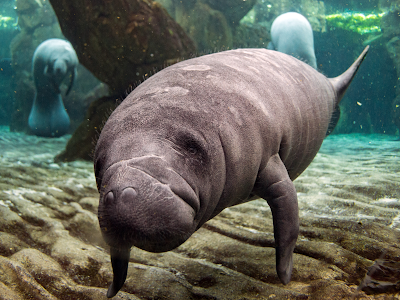 |
| Ichthyosaur Basioccipital Bone / Liam Langley |
Ichthyosaurs became extinct during the Upper Cretaceous, about 30 million years before the K/T extinction event. There was an ocean anoxic event at the Cenomanian–Turonian stage boundary. The deeper layers of the seas became anoxic and poisoned by hydrogen sulphide. As life died off in the lower (benthos) levels of the sea, so did the predators at the top of the food chain. The last pliosaurs and ichthyosaurs became extinct.
Ichthyosaurs had been dwindling in numbers for some time; they were no longer the force they once were in the Upper Triassic and Lower Jurassic. By the middle Jurassic, it was thought they all belonged to the single clade, the Ophthalmosauridae. By the Cretaceous, it was thought that only three genera survived. For the last 50+ years, it has been thought that only one genus, Platypterygius, was known at the time of the anoxic event in the Upper Cretaceous.
 |
| Ichthyosaur Basioccipital Bone / Liam Langley |
By the Cretaceous, they certainly had more competitors than in the Triassic and more elusive prey. The adaptive radiation of teleost fish meant their new prey was fast swimming and highly evasive.
The difference between teleosts and other bony fish lies mainly in their jawbones; teleosts have a movable premaxilla and corresponding modifications in the jaw musculature which make it possible for them to protrude their jaws outwards from the mouth.
This is of great advantage, enabling them to grab prey and draw it into the mouth. In more derived teleosts, the enlarged premaxilla is the main tooth-bearing bone, and the maxilla, which is attached to the lower jaw, acts as a lever, pushing and pulling the premaxilla as the mouth is opened and closed. Other bones further back in the mouth serve to grind and swallow food.
Another difference is that the upper and lower lobes of the tail (caudal) fin are about equal in size. The spine ends at the caudal peduncle, distinguishing this group from other fish in which the spine extends into the upper lobe of the tail fin.
The most basal of the living teleosts are the Elopomorpha, eels and their allies, and the Osteoglossomorpha, those whacky elephantfish and their friends. There are over 800 species of elopomorphs; each with thin leaf-shaped larvae known as leptocephali specialized for a marine environment.
Among the elopomorphs, eels have elongated bodies with lost pelvic girdles and ribs and fused elements in the upper jaw. The 200 species of osteoglossomorphs are defined by a bony element in the tongue. This element has a basibranchial behind it, and both structures have large teeth that are paired with the teeth on the parasphenoid in the roof of the mouth.
The clade Otocephala includes the Clupeiformes, tasty herrings, and Ostariophysi — carp, catfish and their friends. Clupeiformes are made up of 350 living species of herring and herring-like fish. This group is characterized by an unusual abdominal scute and a different arrangement of the hypurals. In most species, the swim bladder extends to the braincase and plays a role in hearing. Ostariophysi, which includes most freshwater fishes, has developed some unique adaptations.
One is the Weberian apparatus, an arrangement of bones, called Weberian ossicles, connecting the swim bladder to the inner ear. This enhances their hearing, as sound waves make the bladder vibrate, and the bones transport the vibrations to the inner ear. They also have a chemical alarm system; when a fish is injured, the warning substance gets in the water, alarming nearby fish. Excellent for the predatory fish, less so for their poor injured brethren.
The teleosts included fast-swimming predatory fish, which would have been competing for similar food resources to our ichthyosaur friends. Had they complained about the teleosts they would have been deeply aghast to know what was coming next — big, hungry mosasaurs. The ichthyosaurs and pliosaurs were replaced in the marine ecology by the giant mosasaurs. The mosasaurs were probably ambush-hunters, whose sit-and-wait strategy apparently proved most successful. So, teleost fish, the ocean anoxic event and the rise of mosasaurs all contributed to the end of the ichthyosaurs.
Photos 1-2: By the awesome Liam Langley
Image 3: By Sir Francis Day - Fauna of British India, Fishes (www.archive.org), Public Domain, https://commons.wikimedia.org/w/index.php?curid=1919094






































